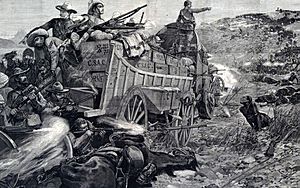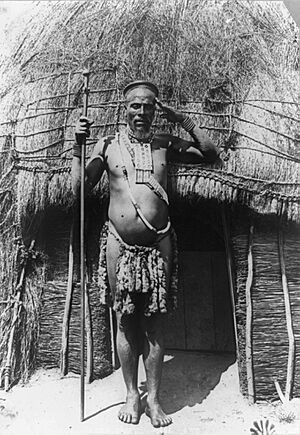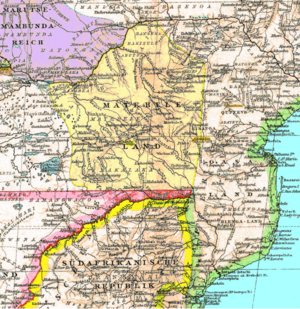First Matabele War facts for kids
Quick facts for kids First Matabele War |
|||||||||
|---|---|---|---|---|---|---|---|---|---|
| Part of the Matabele Wars | |||||||||
 The Battle of the Shangani (25 October 1893), as depicted by Richard Caton Woodville Jr. (1856–1927) |
|||||||||
|
|||||||||
| Belligerents | |||||||||
Tswana (Bechuana) |
Ndebele Kingdom | ||||||||
| Commanders and leaders | |||||||||
| Cecil Rhodes Leander Starr Jameson Major Allan Wilson † Major Patrick Forbes Khama III |
King Lobengula † Mjaan, Chief inDuna |
||||||||
| Strength | |||||||||
| 750 Company troops 1000 Tswana |
80,000 spearmen 20,000 riflemen |
||||||||
| Casualties and losses | |||||||||
| ca. 100 | Over 10,000 | ||||||||
The First Matabele War was a conflict fought between 1893 and 1894 in what is now Zimbabwe. It was a struggle between the British South Africa Company and the Ndebele Kingdom. King Lobengula led the Ndebele people. He tried to avoid a full-scale war with the Company's settlers.
Lobengula and his advisors knew how powerful European weapons were. They understood that these weapons could easily defeat traditional Ndebele impis (warrior units) attacking in large groups. The Ndebele army was very large. It included about 80,000 spearmen and 20,000 riflemen. These riflemen used Martini-Henry rifles, which were modern guns at the time. However, the Ndebele soldiers were not well-trained to use them effectively.
The British South Africa Company had a smaller force. They had about 750 troops in the British South Africa Company's Police. They also had some colonial volunteers and 700 Tswana (Bechuana) allies. Cecil Rhodes, who was a powerful leader, and Leander Starr Jameson, a Company administrator, also wanted to avoid war. They worried that a war would make people lose trust in the future of the territory.
However, tensions grew high. King Lobengula allowed a raid to collect tribute from a Mashona chief. This chief lived near the town of Fort Victoria. This raid led to a direct conflict with the Company.
Contents
How the War Began
The British government gave permission for the British South Africa Company to rule a large area. This area stretched from the Limpopo River to the Zambezi River. Queen Victoria signed this special document, called a royal charter, in 1889. Cecil Rhodes used this charter in 1890. He sent a group of settlers, known as the Pioneer Column, into the region.
These settlers were protected by the well-armed British South Africa Company's Police (BSAP). A famous hunter, Frederick Selous, guided them. They traveled through Matabeleland and into Shona territory. Their goal was to establish Fort Salisbury, which is now Harare.
During 1891 and 1892, King Lobengula made sure his raiding parties stayed away from Mashonaland. This helped prevent clashes between his young warriors and the white settlers. But in 1893, a chief named Gomara in the Victoria district refused to pay tribute. He claimed he was now protected by the settlers' laws.
To save face, Lobengula had to send a raiding party. Several thousand warriors went to bring Gomara back under his control. The raiding party destroyed villages and killed many people. The local British South Africa Company administration felt they had to step in. They didn't want to lose the trust of the local people who asked for help. Company officials told the Ndebele raiders to leave immediately. The Ndebele refused, and fighting broke out. About 40 Ndebele warriors were killed, and they retreated. King Lobengula had warned his fighters: "If you shed one drop of the white man's blood on this raid into Mashonaland, I will have every one of you killed when you return."
Fighting Begins
There was a delay of about two months, from August to October. During this time, Jameson talked with Rhodes in Cape Town. They planned how to gather enough troops to invade Matabeleland.
The BSAP columns rode from Fort Salisbury and Fort Victoria. They met at Iron Mine Hill on October 16, 1893. This spot was near the center of the country. The combined force had about 700 men. Major Patrick Forbes commanded them. They had five powerful Maxim machine guns. Forbes' column then moved towards Bulawayo, the Ndebele capital.
Another force of 700 Tswana allies marched on Bulawayo from the south. This force was led by Khama III, a powerful chief and a strong ally of the British. The Ndebele army tried to stop Forbes from reaching the city. They attacked the column twice as it got closer.
On October 25, 3,500 Ndebele warriors attacked near the Shangani River. Lobengula's troops were well-trained and strong by African standards. But the pioneers' Maxim guns were incredibly effective. An eyewitness said they "mow[ed] them down literally like grass." The Ndebele lost about 1,500 men. The BSAP, however, lost only four men.
A week later, on November 1, 2,000 Ndebele riflemen and 4,000 warriors attacked Forbes again. This time, it was at Bembezi, about 50 kilometers (31 miles) north-east of Bulawayo. Again, they could not stand against the Maxims' crushing firepower. About 2,500 more Ndebele were killed.
King Lobengula fled Bulawayo as soon as he heard the news from Bembesi. Following tradition, he and his people set fire to the royal town as they left. The city's large stores of ivory, gold, and other treasures were destroyed. Its ammunition storage exploded. The fires were still burning when the British marched into the settlement the next day. They set up their base and put up the Company flag and the Union Jack. The rebuilding of Bulawayo began quickly. A new Company-run city rose on the ruins of Lobengula's old home.
Bulawayo Destroyed
The column of Khama's men from the south reached the Tati River. They won a battle on the Singuesi River on November 2. Scouts for the colonial forces, including Burnham and Selous, arrived in Bulawayo that same day. They watched as Lobengula blew up his ammunition rather than let the Company capture it. The town, mostly made of wood huts with mud walls, was largely destroyed.
On November 3, the Victoria column from Mashonaland reached Bulawayo. Jameson and Sir John Willoughby were with them. By this time, Lobengula and his warriors were fleeing towards the Zambezi River. The British tried to get Lobengula to surrender, but he did not reply. The United Salisbury Column later arrived in Bulawayo. On November 13, Major Patrick Forbes organized his column and began chasing Lobengula.
The Shangani Patrol
The group chasing Lobengula faced difficult paths and heavy rains. They did not catch up with him until December 3. Major Allan Wilson led thirty-four troopers, known as the Shangani Patrol. They crossed the Shangani River and camped near Lobengula's location.
During the night, the river rose. Early the next morning, the Ndebele surrounded the Shangani Patrol. They overwhelmed Wilson and his men. All 34 men of the Shangani Patrol died in the fight. The remaining three men, American scouts Frederick Russell Burnham and Pearl "Pete" Ingram, and an Australian named Gooding, crossed the swollen river. Wilson had ordered them to go back to Forbes for help. However, Forbes' forces could not cross the river in time to help.
Ndebele Defeat
King Lobengula's Death
King Lobengula died from smallpox on January 22 or 23, 1894. Meanwhile, the Ndebele warriors slowly lost to the Company's stronger weapons. Soon after the king's death, the Ndebele izinDuna (chiefs) surrendered to the British South Africa Company.
After the war, some people accused the Company of starting the conflict to take Ndebele land. However, after an investigation, the Company was cleared of these charges.
Aftermath of the War
Cecil Rhodes was the main force behind every step the Company took. This was recognized when the Company's territory was officially named "Rhodesia" on May 3, 1895. That year, there was much activity in Matabeleland. Plots of land were sold at very high prices in Bulawayo.
Within nine months, the rebuilt town of Bulawayo had 1,900 settlers. Over 2,000 more prospectors were in the various goldfields. A new company, the African Transcontinental Company, was started. Its goal was to connect Cape Town with Cairo by railway. The railway from Cape Town passed Mafeking and reached the Rhodesian border. It arrived in Bulawayo in 1897. The railway line on the east coast, connecting Salisbury (now Harare) with Beira, Mozambique, was finished in 1899.
The Maxim Gun's Impact
The First Matabele War was the first time Britain used a Maxim gun in battle. It had a huge impact on the war's outcome. In some difficult areas, like hills or thick forests, the Maxim gun didn't kill many enemies directly. But as a psychological weapon, it was very effective. It made the Ndebele feel great fear. It also made the British South Africa Police seem unbeatable. For example, in one battle, 50 Company soldiers with four Maxim guns fought off 5,000 Ndebele warriors.
See also




